#china silk road
Text


The writer, O. Dave Allen is a community activist and political commentator
MONTEGO BAY, Jamaica, January 25, 2022 - We the Jamaican people are at risk of becoming slaves again. We are a country with 95% African people. It’s a fact that the majority of the African population is at the bottom of the economic pyramid while the 5% at the apex are the minorities who control the economy. We all know that the economy is the superstructure that determines everything else, we also know that those who control the economy rules the country. It is time for majority rule.

When the Chinese were commandeering the local retail and distributive business, it was of little concern to the traditional moneyed class. Their long held sense of security is now threatened by the fact that the Chinese have cornered the retail business and have accumulated untold millions, buttressed by unaccountable billions of dollars of dubious origin with an insatiable and avaricious appetite of the tiger spreading their tentacles devouring all that is in its path.
There is an insidious war that is being waged by the Chinese business interest that will undermine all and every local Jamaican business. We are not here dealing with the compliant Chinese shopkeepers of yesteryears; but a contrived network, led by the Chinese State to dominate and control the Jamaica economy with Montego Bay as the entry point, bolstered by the powerful Association of Chinese Enterprises in Jamaica (ACEJ), a non-profit organization.
This mega conglomerate is akin to the Dutch East India Company (The Dutch East India Company historically a military-political-economic complex rather than a pure trading or shipping company).

Can you imagine the consequences when the Chinese would have established their own bank and formal financial intermediaries?
Recently China Harbour Engineering Company (CHEC), was awarded the Government of Jamaica funded US$274.5-million Montego Bay Perimeter Road Project, which includes the rehabilitation of Barnett Street and West Green Avenue, as well as the construction of the Long Hill bypass and a drainage study of the Montego Bay bypass area is also to be conducted under the project.
This catalysis project strengthens the presence of the Chinese in Jamaica and serves as beachhead in Montego Bay to supplant the hegemony of the United States of America in Jamaica and make a mockery of the Monroe Doctrine as they pursue endless war at distant shores.
The Montego Bay perimeter road is funded by the Jamaican taxpayers and as such there is no justifiable reason why this contract should have been awarded to any overseas contractors.
The government has a duty not only to provide physical infrastructure but also to effectively use our taxpayer’s money to build our social capital and to strengthen the capacity of our human resource.
We have developers, engineers, contractors and consultants with more than adequate competencies to develop the Montego Bay Development Road. Our local professionals have demonstrated the capacity to execute and manage major projects as exemplified by the work carried out by Jamaican professionals on the Northern Coastal Highway.

In the recent Andrew Holness cabinet reshuffle the Hon. Homer Davis was appointed to head the Office of the Prime Minister West. This is no accident, but a strategic move to ensure the orderly integration of the Chinese into western Jamaica.
Minister Davis and Former Mayor of the City of Montego Bay enjoys more than cordial relationship with the Montego Bay Chinese community with numerous visits to China during his tenure in office. With the support of the Chinese Dr. Horace Chang remains the most powerful member of the Holness’ Cabinet.
While Bishop O’Neil Russell, and others may be disappointed in the reappointment of Dr. Horace Chang as Minister of National Security, they missed the bigger picture that Chang has consolidated his power base with the appointment of his Deputy General Secretary and his protégé Homer Davis as head of OPM West and the ostensible Emissary of the Chinese community, the new power base in Montego Bay.
To those who sing praises of Homer’s appointment, are living in a fool’s paradise. It is not about you, it is about the Chinese work permits and citizenship, building approvals, the clearance of their goods at the wharf and importantly their security. Homer Davis as a conduit who will ensure that the JLP is fully funded to win the next elections.

There will be a seismic shift in business activities back to the old city of Montego Bay. This regeneration started with Harmony Park, the building out of the downtown Montego Bay Waterfront District and soon the regentrification of the urban centre.
Finally, Who gave the Chinese the permit to dump the wetland and mangrove swamp at Reading to construct the multi story, multi family, high end, Chinese enclave. According to the Ministry of Economic Growth and Job Creation the “project will open new areas to the south of Montego Bay for development and expansion, giving access to lands for housing development.”
But will our local developers; Gore, Moe, Azan, WICHON be beneficiaries of the development opportunities.
China's Silk Road to Montego Bay, “Turn Them Back” ! says O Dave Allen (wiredja.com)
#china silk road#yahoo#jamaica#african#afrakan#kemetic dreams#brownskin#brown skin#afrakans#africans#jamaican#chinese#economic#economy#ecommerce#ecology#ecofriendly#ecosystem#sustainability#waste#tools#electricity#technology
3 notes
·
View notes
Text










The Cryptic Motif of “Three Hares with Conjoined Ears”
On the Heavenly Palace decorative patterns found in the Mogao Caves at Dunhuang from the late Northern dynasties are images with cryptic patterns, including Buddha's head, the Taotie beast, deer, animals copulating, three hares with conjoined ears, and also writings. This type of decorative pattern is cryptic and difficult to understand and may be closely related to the history of the popular Eastern iconology and divination philosophy from the Han and Wei dynasties and Emperor Wu of Northern Zhou's suppression of Buddhism. They are important references for studying the related history of this period.
#china#motif#three hares with conjoined ears#silk road#culture influenced by buddhism from ancient india#art#reference
705 notes
·
View notes
Text

I'd like to think that we ruled the world for a short moment in time.
femslash february day 1: POWER
#hetalia#indchu#nyo india#nyo china#femtalia24#yes I am ONE WEEK LATE to DAY 1 of femtalia#I’m so embarrassed I am never promising anything again I am a fool I'm so sorry#but indchu…. god they’re amazing…. literally crying as I go thru their history#the real Silk Road pair don’t @ me#kikidoodlez
320 notes
·
View notes
Text

Uyghur bread, Xinjiang China.
959 notes
·
View notes
Text
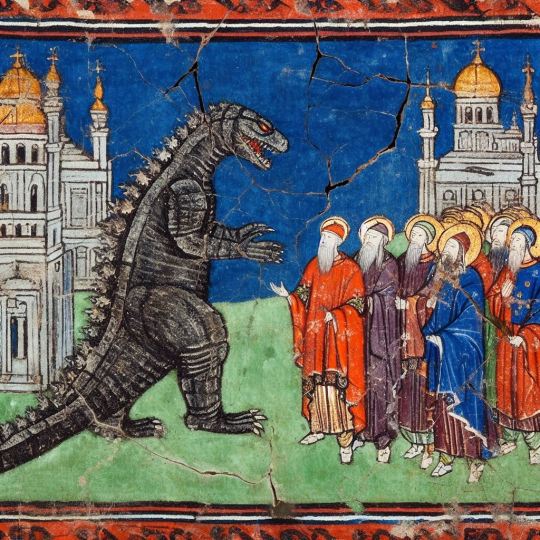
Godzilla was chosen by Byzantine emperor Andronikos II Palaiologos to meet the first Chinese delegation sent to Europe in the 14th century.
160 notes
·
View notes
Text




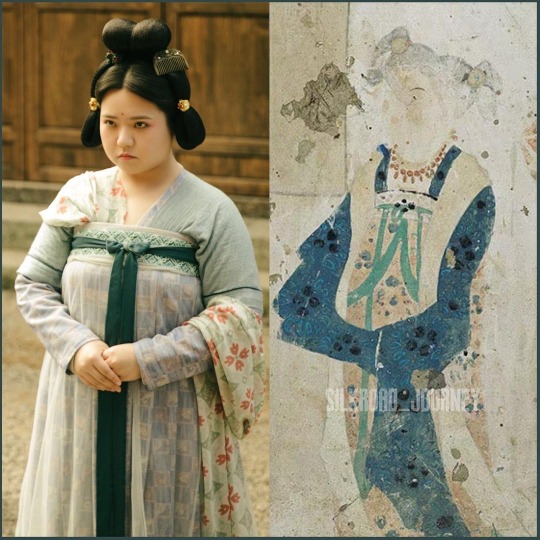
Tang dynasty period drama (Luoyang 风起洛阳) 2021
Most of the C-drama costumes are restored based on real Tang dynasty paintings from the Mogao Caves. These are some examples.
Photos credit: silkroad_journey on Instagram.
#chinese history#chinese culture#hanfu#tang dynasty#Buddhism#mogao caves#China#silk road#ancient china#Medieval China#chinese drama#cdrama#hanfu recreation#Hanfu restoration#dynastic china#art
290 notes
·
View notes
Text
Chemistry Behind Ancient Pigment, 'Chinese Purple'

In ancient times, rare non-natural pigments, especially blues and purples. 'Chinese Purple' or 'Han Purple' a Barium Copper Silicate BaCuSi₂O₆ pigment, emerged from the Western Zhou to the Han Dynasty, found in terracotta army garments at the Qin Shi Huang Mausoleum. Initially linked to Egyptian Blue, Chinese Purple predates Silk Road contacts by centuries, suggesting an independent discovery.
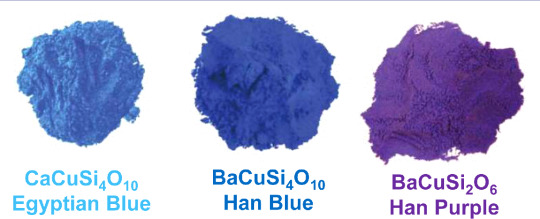
Likely an alchemical serendipity during Daoist experiments, its compounds—copper, barium, and lead—aligned with materials used by Daoist alchemists in creating ancient lead-barium glass.
#purple#ancient history#pigment#ancient china#chemistry#ancient culture#terracotta#silk road#interesting stuff#amazing facts#history
83 notes
·
View notes
Note
there was Chinese interest in the Out Of Asia theory, in both the Republic, Chiang Republic and People’s Republic periods before the Out Of Africa theory became commonly accepted. Was the 1954 Yeti expedition done just from the Nepalese-Indian side or were the American agents and “anthropologists” given access on the Sino-Tibetan side of the Himalayan border?
During the early part of this century, it was absolutely believed for a long time that the deserts of Western China were the most likely place of human origins, as seen in this migration map from 1944, made from the best available knowledge of the time:
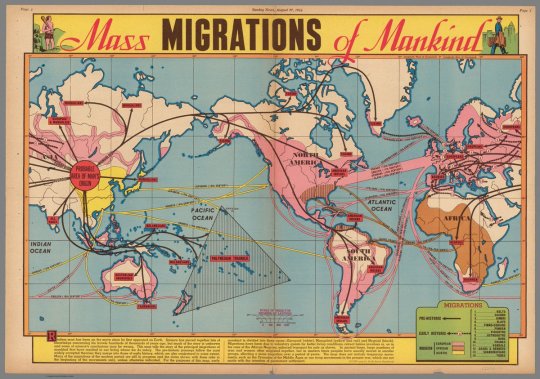
Remember, the oldest fossil remains at this point were in China, where Homo erectus was discovered (originally known by his initial place of discovery in Chungkotien Cave, nicknamed "Peking Man"). The discovery of Australopithecus and Homo habilis in Olduvai Gorge and South Africa, which place human origins in Africa, were not until the 50s and 60s, so it seemed entirely reasonable that Homo sapiens evolved in Western China.
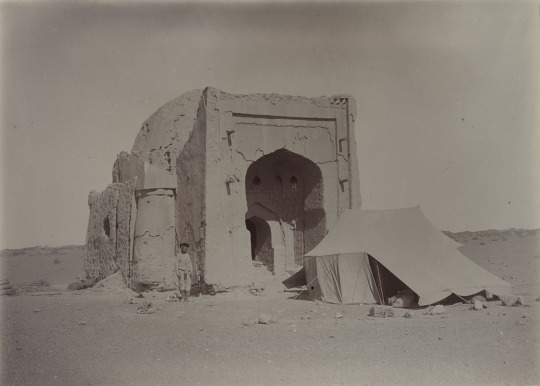
The idea that China's desert regions were the origin of modern humans and culture is seen a lot in pop culture from 1900-1950, mainly because there were tremendous explorations in the region, especially Aurel Stein's expedition of 1908, who ventured into the Taklamakan Desert to find the Dunhuang Caves and Khara-Khoto, a city destroyed completely by Genghis Khan and vanished in the desert.
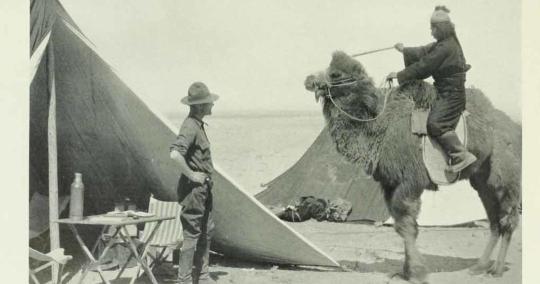
If you've ever heard of Roy Chapman Andrews and his famous expeditions in the 1920s, it's worth noting that he ventured into the Gobi Desert looking for human remains....not dinosaurs, and the discovery of dinosaur eggs was an unexpected surprise.
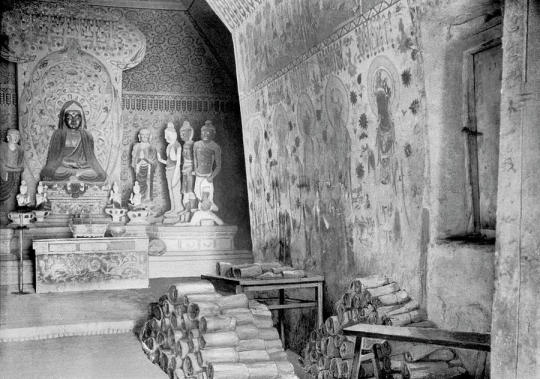
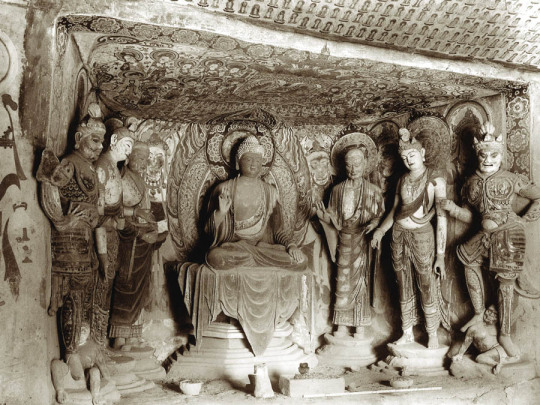
For that reason, there was a short lived Silk Road Mania that seemed to be a smaller scale predecessor to the pop culture dominating Egyptomania of the 1920s. It's bizarre to read adventure and fantasy fiction of the 1910s-1920s that features mentions of Silk Road peoples like the Kyrgyz, Sogdians, Tajik, Uigurians, and Tuvans. The best example I can think of would be the Khlit the Kossack stories of Harold Lamb (who also wrote a biography of Tamerlane), which together with Tarzan and Tros of Samothrace, formed the core inspiration for Robert E. Howard's Conan the Barbarian.
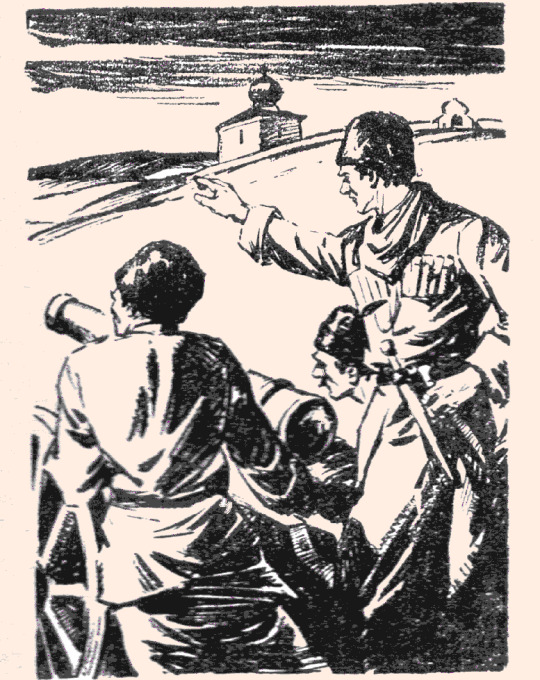
The most interesting example of this would be A. Merritt's Dwellers in the Mirage, which featured a lost city in Xinjiang that was the home of the Nordic race, who worshipped their original religion, the kraken-like squid devil god Khalkru. It was widely believed in this era that Nordics emerged from Central Asia originally, and while it's easy to write this off as turn of the century racialist claptrap pseudohistory (along with Hyperborea legends), in this case, it is actually true: a branch of the Indo-European family lived in West China, and 5,000 year old redheaded mummies have been found in the region. As usual, A. Merritt was right on the money with his archeology, more so than other 1920s authors. After all, his "Moon Pool" was set around the just discovered ruins of Nan Madol, the Venice of Micronesia.

Jack Williamson's still chilling Darker Than You Think in 1948 was also set in the Silk Road/Central Asian region, as the place the race of shapeshifters emerged from, Homo magi, who await the coming of their evil messiah, the Night King, who will give them power over the human race.
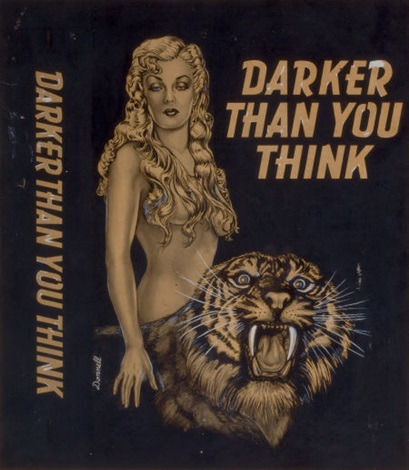
H. Rider Haggard set "Ayesha: the Return of She" (1905) in Xinjiang, among a lost Greek colony in Central Asia (no doubt based on Alexandria on the Indus, a Greek colony in modern Pakistan that was the furthest bastion of Greek Culture). This was also two years after the Younghusband Thibetan Expedition of 1903, where the British invaded Tibet. At the time, the Qing Dynasty was completely declining and lost control of the frontier regions, and the power vacuum was filled by religious authority by default (this is something you also saw in Xinjiang, where for example, the leader of the city was the Imam of Kashgar).
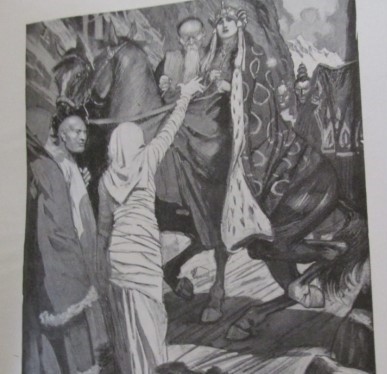
This is one of the many British invasions they have attempted to cram down the memory hole, but if you ever see a Himalayan art piece that was "obtained in 1903-1904" ....well, you know where it came from.
Incidentally, there's one really funny recent conspiracy theory about paleontology, fossils, and China that I find incredibly interesting: the idea that dinosaurs having feathers is a lie and a sinister plot spread by the Communist Chinese (who else?) to make American youth into sissy fancylads, like Jessie "the Body" Ventura. How? By lying to us and making up that the manly and vigorous Tyrannosaurus, a beast with off the charts heterosexuality and a model for boys everywhere, might have been feathered like a debutante's dress. What next - lipstick on a Great White Shark? The long term goal is to make Americans effeminate C. Nelson Reilly types unable to defend against invasion. This is a theory that is getting steam among the kind of people who used to read Soldier of Fortune magazine, and among abusive stepfathers the world over.

...okay, are you done laughing? Yeah, this is obvious crackpottery and transparent sexual pathology, on the level of the John Birch Society in the 60s saying the Beatles were a Communist mind control plot. Mostly because animals just look how they look, and if it turned out that the ferocious Tyrannosaurus had feathers and looked like a fancylad Jessie Ventura to you, well, that's your problem and mental baggage, really.
I was left scratching my head over this one. But there is (kind of) something to this, and that is that a huge chunk of recent dinosaur discoveries have been in China. I don't think it has anything to do with a Communist plot to turn American boys into fancylads, but more to do with a major push in internal public investment in sciences in that country, and an explosion of Chinese dinosaur discoveries. If you want to see a great undervisited dinosaur museum, go to the Zigong Dinosaur Museum in Sichuan.

Pop quiz: what living scientist has named more dinosaur discoveries? It's not Bakker or Horner. The greatest living paleontologist, Xu Xing, which is why a lot of recently found dinosaurs are named things like Shangtungasaurus.
250 notes
·
View notes
Text

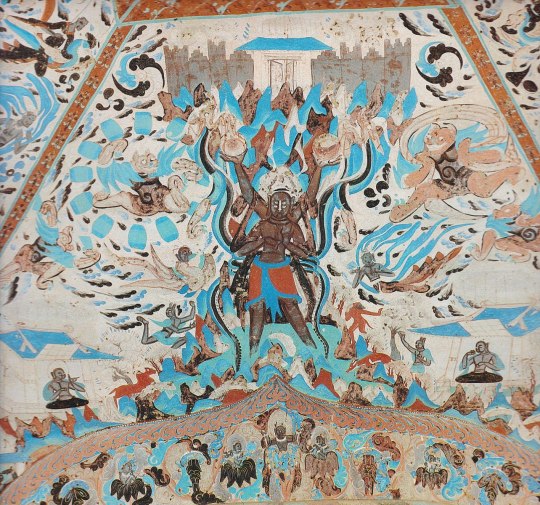
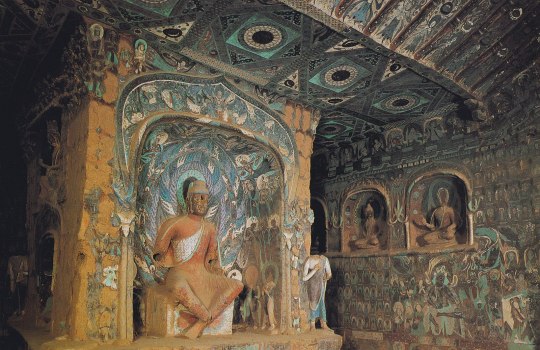

Much of the art in the medieval Buddhist temple-caves at Dunhuang was meant to inspire monks in their meditation. This is the art that is truly spectacular. It’s meant to be mind-blowing, to obliterate monks’ egos and help them to attain nirvana — literally, the blowing out of the flame of desire.
Artists created swirling, complex tableaux of people, animals, and supernatural figures. This was known as the "thousand-Buddha" style -- every square inch of the caves was covered with religious art.
{WHF} {Ko-Fi} {Medium}
202 notes
·
View notes
Text
The Monkey King - Sun Wukong who first appears in Chinese stories (Journey to the West) during the Ming Dynasty period 1368 to 1644 CE, well after the introduction of Buddhism to China in about 206-220 CE.
But, was he inspired by another Monkey hero/character of myth?

The prevailing and dominant theory among Asian scholars is ...yeah, likely.
That character, Hanuman, king of the monkeys (the monkey people -Vanaras- of Vedic myth!).
The story follows a Buddhist monk who is accompanied by Sun Wukong and others to travel west to India to obtain sacred Buddhist sutras. Many of their powers and personality traits are similar as well.
We know that Vedic god such as Indra have made their way as far as Japan to take root and be worshipped because of the spread of Buddhism.
As I've talked about before and is shown in texts such as the journey's of Ibn Battuta / Ibn Fadlan, storytelling was a weapon and powerful tool for idea transfer--propagation. Philosophy was huge in the old world - and places such as Nalanda - the first residential university in the world - invited scholars from all over such as Greeks from the west, and the Japanese. Buddhism became a vehicle for trading things such as: martial arts information, medicine, sciences, and of course, myths and stories.
However, as with stories, people usually altered/coopted elements and molded them to better suit their cultures and fancy. That's a thing as old as time. I've shared how the panchatantra stories and jatka tales are thought to be the inspiration for nearly 30-50 percent of all nursery rhymes, ballads, "fairy tales".
Anyways back to this theory - Chinese Indologist Professor Liu Anwu of Peking University has dedicated chapters to the comparisons (in one of his works) to further break down this theory focusing on consistent and or similar depictions of beats in Journey to the West that of Rama's story in Ramayama and the Buddhist sutras.
Even though today the story of Sun Wukong is a wholly Chinese story - it's important to note the power of oral storytelling and how it travelled evolved over thousands of years, and, just as important, the vehicles it used to do so. Not just storytellers and philosophers and travelers but religion! Philosophy!
This is a theme heavily commented on and shown in Tales of Tremaine, which is my love letter and sort of self PhD. in comparative storytelling, mythology, and story foundry through an Asiatic lens (hence a silk road analog) stretching along a similar route the silk road did from damn near as far as you can east (complete with the oceanic routes) to as west as old venezia, portugal, and spain.
Also note: this is the most popular theory atm, but the operative word is theory. Experts likely far better than you, Internet, so chill before you comment, are still debating this. I know last week some of you were doctors in sociopolitical relations, the music industry before that, and then you were leading virologists before that. Spare us simpler folks from your mighty genius just now and sit down.
The point here is the beauty of stories and their ability to travel and morph and comment on themes/points ideologies important to cultures while being entertaining and showing that humans like certain universal moments, beats, archetypes, tropes, and progressions in tales.
Now, is that because we've naturally been predisposed liking them, or the opposite in that everyone went, yo, i dig this, took it home and someone else went, this is cool but needs to be more US (insert culture) and retold it. And thus...timemachine noises speed up. Here we are today?
You might not know that about 35,000 Chinese words ( I said this instead of Mandarin because they don't just show up in one language) are derived from Sanskrit as well as Pali (a Middle Indo-Aryan Liturgical Language -- meaning language of sacredness/religious use, in this case connected to sacred Buddhist texts). It is important to make the distinction, because, Internet!
Sanskrit did not SHAPE the Chinese languages. They evolved on their own. This is just a commentary on how words/stories shaped over travel in this case strongly through the spread of Buddhism.
Religion was the mover.
Back from quick bathroom break. Going to add again - INSPIRED is the keyword here.
INSPIRED.
Sun Wukong is his own mythos/character. Influence doesn't nor can claim dominion over everything in a later tale. Sun Wukong has gone on himself to inspire legends and characters Outside of China - re: most famously and legendary?
Son Goku - who is openly a Sun Wukong inspired character.
...hell, tbh, he might be the most famous monkey inspired super powered character now. Dude makes soccer stadiums air his fights. @_@.

#monkey king#monkey king journey to the west#hanuman#buddhist#buddhist monk#sun wukong#vedic gods#Japan#China#chinese legend#storytelling#mythology#myths and legends#asian mythology#mandarin#Sanskrit#pali#chinese language#dbz#dragon ball#dragon ball z#inspired#inspired by#the silk road#silk road retelling#philosophy#philosophers#journey to the west#fairy tales#nursery rhymes
34 notes
·
View notes
Text
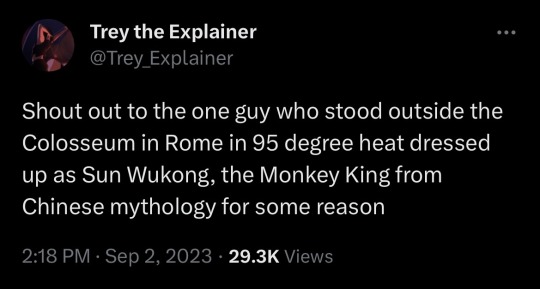
how can I make this about romechu
#romechu#silk road pair#hws rome#hws china#hetalia#I LITERALLY WALKED BY THIS GUY BTW…..I internally geeked out he looked SOOOOO cool
73 notes
·
View notes
Text
The penetration of China by Buddhism not only gave the Chinese a new religion but, of central importance to this narrative, it gave to the world an entirely new style of art which has come to be known as Serindian. This term is coined from the two words Seres (China) and India. Logically it should have been simply a fusion of Indian Buddhist art and the art of contemporary Han China. It almost certainly would have been had it not been for the great Himalayan massif which so effectively isolated China from all direct contact with India. But faced by this impenetrable barrier, the gospel of Buddhism together with its art came to China by a roundabout route, gradually absorbing other influences on its way. Its real point of departure was not India proper but the Buddhist kingdom of Gandhara, situated in the Peshawar valley region of what is now north-western Pakistan. Here another artistic marriage had already taken place. This was between Indian Buddhist art, imported by the ruling Kushans (descendants of the Yueh-chih) in the first century AD, and Greek art, introduced to the region four hundred years earlier by Alexander the Great.
The most revolutionary product of this Graeco-Buddhist, or Gandharan, school was the depiction of Buddha in human form, for it was the first time that artists anywhere had allowed themselves to show him thus. As a being who had ceased to exist, theologically speaking, by achieving Nirvana and thus escaping the endless cycle of rebirth, he had always been portrayed before by means of a mystical symbol such as a single footprint, a wheel, a tree, a stupa or Sanskrit characters. But the Gandharan Buddha is shown by sculptors with straight, sharply chiselled nose and brow, classical lips and wavy hair–all Hellenistic influences. Another obvious Mediterranean introduction is the diaphanous, toga-like robe he wears in place of the expected loin cloth. But his eyes are heavy-lidded and protruding, the lobes of the ears elongated, and the oval-shaped face fleshy–all characteristics of Indian iconography. The stretched ear lobes symbolise Buddha’s casting away of the heavy, jewelled and worldly earrings that he had worn as a wealthy prince before his conversion to a life of self-denial and teaching
—Peter Hopkirk, Foreign Devils on the Silk Road: The Search for the Lost Cities and Treasures of Chinese Central Asia
#peter hopkirk#foreign devils on the silk road#history#china#india#gandhara#Buddhism#art#w#2024 reads#upl#reading through the silk road
28 notes
·
View notes
Text
breaking news: love and deepsapce just released its PV for new card on Sep 23 with all four dressed in chinese fashion in tang dynasty style
#china#fashion#chinese fashion#love and deepspace#lnds#lads#lads xavier#lads zayne#Both xavier and zayne are wearing hanfu#rafayel looks like Persian style dress or dunhuang style (silk road influence at the time)#sylus looks like northern hun style#Why don't they do long hair? Obviously long hair looks better and goes better with the outfit#I guess that long hair modeling is too complicated and costly
123 notes
·
View notes
Photo
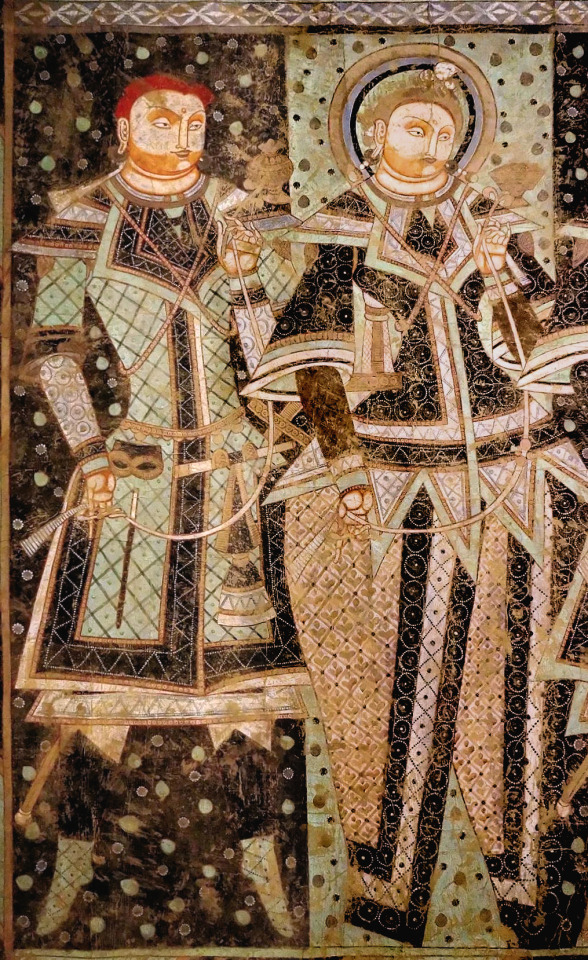

Tocharian donors, Kizil caves, 6-7th century
119 notes
·
View notes
Text

Boys in Kashgar, Uyghur Autonomous Region
51 notes
·
View notes
Text

"I'd rather be a dog’s or a pig’s wife than yours!" In this 4th-c. letter, a Sogdian woman writes to the husband who abandoned her in Dunhuang. Alas, it was found in a lost postbag and never reached its recipient!"
International Dunhuang Programme:
https://x.com/idp_uk/status/1275715285606182914
10 notes
·
View notes